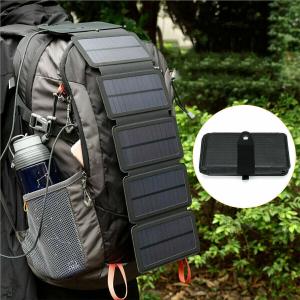

Add to Cart
Portable Solar Panel
| Solar Panel Output | 5V/1A Max |
| Solar Panel Type | Monocrystalline Silicon |
| Conversion Efficiency | >19.5% |
| USB Output | 1 x 5V / 2A Max |
| Unfoldable Size | 65x10x3cm/25.6*3.9*1.2in |
| Foldable Size | 18.5x11.5x2cm/7.3*4.5*0.8in |
【High Energy Conversion Solar Panel Charger】Highly efficient Solar Power panel, , up to 19.5% energy conversion rate in sufficient sunlight. And this special PET polymer surface protects it from occasional rain or wet Fog and all the ports are covered by a cloth flap and rubber cover to protect them from dust or water damage.
【Durable Advanced Single Crystal Panel】Compared with polycrystalline panels, Monocrystalline solar charging panels can achieve higher conversion rates, are rugged and durable, are not easily damaged, and have a service life of up to 15 years and up to 25 years.
【Easy To Carry】Our foldable solar charger panel is small and light easy to fit into any camping backpack, traveling backpack. Made of waterproof material, provides complete waterproof performance (excluding USB output).
Feature:
100% brand new and high-quality made.
Equipped with solar energy and efficient solar charger circuit.
Comes with environmental protection and energy inexhaustible.
Class A single crystal silicon with a conversion rate of 19.5%.
Portable and frame design fit for outdoor and indoor usage.
Waterproof surface along with LED charging light.
Slim & Light design with 3mm thickness.
The principle of solar cell phone charger is to convert solar
energy into electrical energy and store it in the solar cell phone
charger.
In the built-in battery, when the mobile phone needs to be charged,
the battery in the solar mobile phone charger will output power to
charge the mobile phone.
solar panel
The conversion rate of currently marketed solar panels is still
relatively low, generally only 16.5%. Some domestic products can
achieve 17%, and some people abroad have achieved 25%.
Researchers at Rensselaer Polytechnic Institute in the United
States developed a new coating in 2008. Covering it on solar panels
can increase the solar absorption rate of the latter to 96.2%,
while the sunlight absorption rate of ordinary solar panels is only
About 70%.
The new coating mainly solves two technical problems. One is to
help the solar panels absorb almost the entire solar spectrum. The
other is to enable the solar panels to absorb sunlight from a
larger angle, thus improving the efficiency of the solar panels in
absorbing sunlight. .
Ordinary solar panels can usually only absorb part of the solar
spectrum, and usually only work more efficiently when absorbing
direct sunlight. Therefore, many solar installations are equipped
with automatic adjustment systems to ensure that the solar panels
are always aligned with the sun for optimal absorption. energy
perspective.
